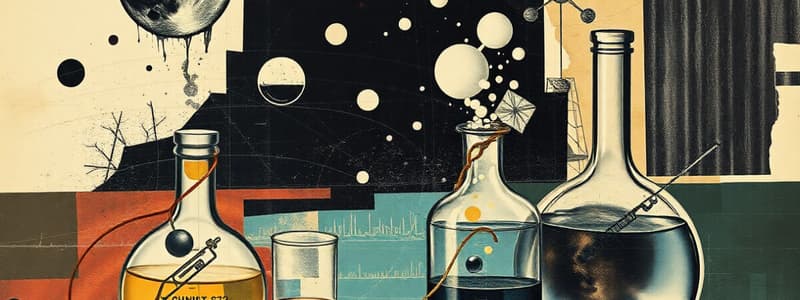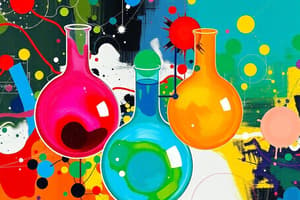Podcast
Questions and Answers
Which of the following is an example of a chemical change?
Which of the following is an example of a chemical change?
- Dissolving sugar in water
- Boiling water
- Melting ice
- Burning wood (correct)
Intensive properties, such as mass and volume, depend on the amount of substance present.
Intensive properties, such as mass and volume, depend on the amount of substance present.
False (B)
What type of mixture has a uniform composition throughout?
What type of mixture has a uniform composition throughout?
Homogeneous Mixture
The simplest whole-number ratio of atoms in a compound is represented by the ______ formula.
The simplest whole-number ratio of atoms in a compound is represented by the ______ formula.
Match the following separation techniques with their appropriate use:
Match the following separation techniques with their appropriate use:
Which subatomic particle has a positive charge and is located in the nucleus of an atom?
Which subatomic particle has a positive charge and is located in the nucleus of an atom?
Isotopes are atoms of the same element with the same number of neutrons but different numbers of protons.
Isotopes are atoms of the same element with the same number of neutrons but different numbers of protons.
What term is used for an atom that has gained electrons?
What term is used for an atom that has gained electrons?
A chemical bond formed through the sharing of electrons between two nonmetals is called a ______ bond.
A chemical bond formed through the sharing of electrons between two nonmetals is called a ______ bond.
Which of the following represents the molar mass of a substance?
Which of the following represents the molar mass of a substance?
Stoichiometry involves the study of qualitative relationships between reactants and products in chemical reactions.
Stoichiometry involves the study of qualitative relationships between reactants and products in chemical reactions.
In a chemical reaction, what is the limiting reactant?
In a chemical reaction, what is the limiting reactant?
In a solution, what is the substance that does the dissolving?
In a solution, what is the substance that does the dissolving?
Acids ______ protons (H+) in water, while bases accept them.
Acids ______ protons (H+) in water, while bases accept them.
Which of the following describes oxidation?
Which of the following describes oxidation?
Flashcards
Physical Change
Physical Change
A change in the form or appearance of a substance, but not its chemical composition.
Chemistry
Chemistry
The study of matter, its properties, and how it changes.
Matter
Matter
Anything that has mass and takes up space.
Mixture
Mixture
Signup and view all the flashcards
Elements
Elements
Signup and view all the flashcards
Atoms
Atoms
Signup and view all the flashcards
Atomic Number (Z)
Atomic Number (Z)
Signup and view all the flashcards
Isotopes
Isotopes
Signup and view all the flashcards
Ions
Ions
Signup and view all the flashcards
Empirical Formula
Empirical Formula
Signup and view all the flashcards
Covalent Bonds
Covalent Bonds
Signup and view all the flashcards
The Mole (mol)
The Mole (mol)
Signup and view all the flashcards
Limiting Reactant
Limiting Reactant
Signup and view all the flashcards
Molarity (M)
Molarity (M)
Signup and view all the flashcards
Oxidation
Oxidation
Signup and view all the flashcards
Study Notes
- Chemistry is the study of matter, its properties, and how matter changes
- Matter has mass and occupies space
States of Matter
- Solids possess a definite shape and volume
- Liquids have a definite volume but take the shape of their container
- Gases lack a definite shape or volume, expanding to fill available space
- Plasma constitutes an ionized gas
Properties of Matter
- Physical properties can be observed or measured without altering a substance's composition; examples include color, density, and melting point
- Chemical properties describe how a substance transforms into a new one, such as flammability and reactivity
- Intensive properties, like density and temperature, are independent of the amount of substance
- Extensive properties, such as mass and volume, depend on the amount of substance
Chemical Change vs Physical Change
- Physical changes alter the form or appearance of a substance without changing its chemical composition, such as melting or boiling
- Chemical changes result in a change in chemical composition, forming a new substance, like burning or rusting
Mixtures
- Mixtures are combinations of two or more physically combined substances
- Homogeneous mixtures exhibit uniform composition throughout, like saltwater
- Heterogeneous mixtures have non-uniform composition with easily distinguished components, like salad dressing
Pure Substances
- Elements cannot be broken down into simpler substances by chemical means, examples being gold and oxygen
- Compounds consist of two or more elements chemically combined in a fixed ratio, examples being water and salt
Separation Techniques
- Distillation separates liquids based on differing boiling points
- Filtration separates solids from liquids
- Chromatography separates substances based on affinities for stationary and mobile phases
- Evaporation separates a soluble solid from a liquid
Atoms
- Atoms are the fundamental building blocks of matter
- Atoms comprise protons, neutrons, and electrons
- Protons are positively charged particles within the nucleus
- Neutrons are neutral particles located in the nucleus
- Electrons, negatively charged, orbit the nucleus
Atomic Number and Mass Number
- Atomic number (Z) represents the number of protons in an atom, determining the element
- Mass number (A) indicates the total count of protons and neutrons in an atom
Isotopes
- Isotopes are atoms of the same element with varying neutron counts
- Isotopes share the same atomic number but differ in mass numbers
Ions
- Ions are atoms that have either gained or lost electrons
- Cations are positively charged ions (resulting from electron loss)
- Anions are negatively charged ions (resulting from electron gain)
Molecules and Chemical Formulas
- Molecules consist of two or more atoms held together by chemical bonds
- Chemical formulas represent the number and type of atoms in a molecule, such as H2O and CO2
Empirical and Molecular Formulas
- Empirical formula denotes the simplest whole-number ratio of atoms in a compound
- Molecular formula indicates the actual number of atoms of each element in a molecule
- The molecular formula is a multiple of the empirical formula
Chemical Bonds
- Ionic bonds arise from electron transfer between a metal and a nonmetal
- Covalent bonds form through electron sharing between two nonmetals
- Metallic bonds are found in metals, where electrons are delocalized
Naming Compounds
- Ionic compounds (metal + nonmetal) are named by stating the metal and adding "-ide" to the nonmetal; NaCl is sodium chloride
- Covalent compounds use prefixes to denote atom numbers; CO2 is carbon dioxide
- Acids produce H+ ions in solution and follow specific naming rules
The Mole
- The mole (mol) is a unit of amount; 1 mole equals 6.022 x 10^23 entities (Avogadro's number)
- Molar mass represents the mass of one mole of a substance (g/mol)
- Used for conversions between mass and moles
Stoichiometry
- Stoichiometry involves quantitative relationships between reactants and products in chemical reactions
- Balanced chemical equations are crucial for stoichiometric calculations
- Mole ratios are derived from coefficients in a balanced equation
Limiting Reactant and Percent Yield
- The limiting reactant is fully consumed in a reaction, dictating the amount of product formed
- Theoretical yield is the product amount formed based on the limiting reactant
- Actual yield is the product amount obtained in a reaction
- Percent yield is calculated as (Actual yield / Theoretical yield) x 100%
Solutions
- Solutions are homogeneous mixtures of two or more substances
- The solute is the substance being dissolved
- The solvent is the substance doing the dissolving
- Aqueous solutions use water as the solvent
Concentration
- Concentration is the amount of solute in a given amount of solvent or solution
- Molarity (M) is defined as moles of solute per liter of solution (mol/L)
- Molality (m) is defined as moles of solute per kilogram of solvent (mol/kg)
Acids and Bases
- Acids donate protons (H+) in water
- Bases accept protons (H+) in water
- The pH scale measures acidity or basicity (0-14)
- pH < 7 indicates an acidic solution
- pH = 7 indicates a neutral solution
- pH > 7 indicates a basic solution
Oxidation and Reduction
- Oxidation involves the loss of electrons
- Reduction involves the gain of electrons
- Redox reactions involve electron transfer
Organic Chemistry
- Organic chemistry is the study of carbon-containing compounds
- Hydrocarbons consist solely of carbon and hydrogen
- Functional groups are groups of atoms that impart characteristic properties to organic molecules
Studying That Suits You
Use AI to generate personalized quizzes and flashcards to suit your learning preferences.
Description
Explore the fundamental concepts of chemistry, including the definition and states of matter (solid, liquid, gas, plasma). Learn about physical and chemical properties, and differentiate between intensive and extensive properties. Understand the differences between physical and chemical changes.




